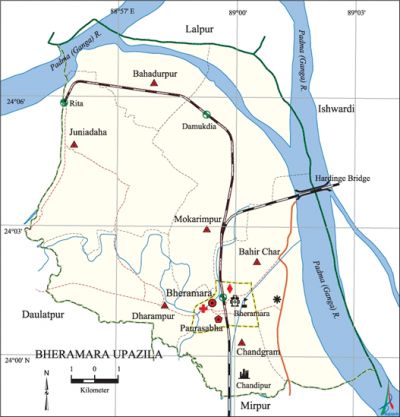Bheramara Upazila
Bheramara Upazila (kushtia district) area 153.71 sq km, located in between 23°59' and 24°07' north latitudes and in between 88°00' and 89°12' east longitudes. It is bounded by lalpur upazila on the north, mirpur (Kushtia) upazila on the south, ishwardi upazila on the east, daulatpur (Kushtia) upazila on the west.
Population Total 200084; male 98822, female 101262; Muslim 195603, Hindu 4433, Buddhist 36, Christian 10 and others 2.
Water bodies Main river: padma; Damodar Beel is notable.
Administration Bheramara Thana was formed in 1906 and it was turned into an upazila on 7 November 1983.
| Upazila | ||||||||
| Municipality | Union | Mouza | Village | Population | Density (per sq km) | Literacy rate (%) | ||
| Urban | Rural | Urban | Rural | |||||
| 1 | 6 | 42 | 77 | 30747 | 169337 | 1302 | 62.7 (2001) | 45.5 |
| Municipality | ||||||||
|
Area |
Ward |
Mahalla |
Population|
Density |
Literacy rate | ||||
| 3.26 (2001) | 9 | 15 | 22124 | 6258 (2001) | 71.4 | |||
| Upazila Town | ||||||||
|
Area |
Mouza |
Population |
Density |
Literacy rate | ||||
| 6.10 (2001) | 3 | 8623 | 1244 (2001) | 52.4 | ||||
| Union | ||||
| Name of union and GO code | Area (acre) | Population | Literacy rate (%) | |
| Male | Female | |||
| Chandgram 40 | 2506 | 8457 | 8617 | 47.9 |
| Juniadaha 67 | 8565 | 17059 | 17634 | 42.2 |
| Dharampur 54 | 5250 | 18439 | 18381 | 47.4 |
| Bahadurpur 13 | 4179 | 14298 | 14725 | 43.8 |
| Bahir Char 27 | 6399 | 12227 | 12688 | 51.6 |
| Mokarimpur 81 | 10098 | 17402 | 18033 | 44.5 |
Source Bangladesh Population Census 2001 and 2011, Bangladesh Bureau of Statistics.

Archaeological heritage and relics Georgebari at village Chandipur (1889), Jagatjanani Mandir.
Historical events The peasants of the upazila participated in the indigo resistance movement at Shalghar Madhua in 1860. The people of the upazila also participated in the [Faraizi Movement|faraizi movement]].
War of Liberation During the war of liberation in 1971 the hardinge bridge of Bheramara was affected. The Pak army conducted mass killing and plundering in the area and also set many houses on fire. Two big encounters between the freedom fighters and the Pak army took place at Sholadag village of Bahirchar union and near the graveyard adjacent to the railgate of Bheramara municipality. A mass grave has been discovered in the upazila.
For details: see ভেড়ামারা উপজেলা, বাংলাদেশ মুক্তিযুদ্ধ জ্ঞানকোষ (Encyclopedia of Bangladesh War of Liberation), বাংলাদেশ এশিয়াটিক সোসাইটি, ঢাকা ২০২০, খণ্ড ৭।
Religious institutions Mosque 620, temple 10, tomb 2, most noted of which is Satbaria Mosque.
Literacy rate and educational institutions Average literacy 48.7%; male 48.7%, female 48.7%. Educational institutions: college 5, secondary school 27, primary school 55, madrasa 8. Noted educational institutions: Bheramara Pilot High School, Juniadaha Secondary School (1872), Bahadurpur Secondary School, Bheramara Model Primary School (1869).
Newspapers and periodicals Daily: Kushtia Darpan; Weekly: Simanta Katha, Mukur, Oborudho Kantha; Monthly: Kakoli; Bimonthly: Ovijan.
Cultural organisations Library, club, press club, theatre group, women's organisation, literary and cultural group, music school, Silpakala Academy, cinema hall.
Important installations and Tourist spots Hardinge Bridge (1912), Bheramara Thermal Power Station, ganges-kobadak irrigation project, GK Pump House, Sulaiman Shah's Mazar.
Main sources of income Agriculture 46.57%, non-agricultural labourer 6.26%, industry 2.12%, commerce 17.62%, transport and communication 4.36%, service 9.25%, construction 1.91%, religious service 0.16%, rent and remittance 0.56% and others 11.19%.
Ownership of agricultural land Landowner 42.86%, landless 57.14%; agricultural landowner:' urban 38.31% and rural 43.68%.
Main crops Paddy, wheat, mustard, sweet potato, sunflower, betel leaf, tobacco, sugarcane, vegetables.'
Extinct or nearly extinct crops Sesame, kaun, linseed.
Main fruits Mango, banana, jackfruit, papaya, kamranga, plum, watermelon, blackberry.
Fisheries, dairies and poultries Fishery 80, dairy 5, poultry 59.
Communication facilities Roads: pucca 156 km, semi-pucca 31 km, mud road 353 km; waterway 10 km; railway 10 km.
Extinct or nearly extinct traditional transport Palanquin, bullock cart and horse carriage.
Noted manufactories Salt factory, bidi factory, chemical industry, welding factory.
Cottage industries Weaving, 'potteries, embroidery, wood work, bamboo and cane work.
Hats, bazars and fairs Hats and bazars are 30, fairs 2, most noted of which are Satbaria, Juniadaha, Golapnagar, Kuchiamora, Bahadurpur, Arkandi hats and Ghora Shaha Mazar Mela.
Main exports Tobacco, betel leaf.
Access to electricity All the wards and unions of the upazila are under rural electrification net-work. However 67.3% of the dwelling households have access to electricity.
Sources of drinking water Tube-well 95.0%, tap 1.9% and others 3.1%.
Sanitation 67.8% of dwelling households of the upazila use sanitary latrines and 29.9% of dwelling houses use non-sanitary latrines; 2.3% of households do not have latrine facilities.
Health centres Upazila health complex 1, clinic 1, family planning centre 8.
NGO activities Operationally important NGOs are brac, asa, Uddipan. [Arif Nisir]
References Bangladesh Population Census 2001 and 2011, Bangladesh Bureau of Statistics; Cultural survey report of Bheramara Upazila 2007.
